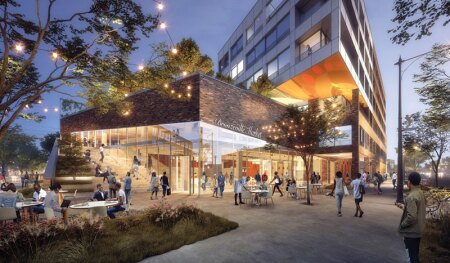
The Legacy District, winner of Chicago’s INVEST South/West Bronzeville RFP, will be erected at 47th Street and Vincennes Avenue in Chicago and will feature a six-story building with 12,000 square feet (1,100 sq m) of commercial space and 25 mixed-income residential units. (Rendering courtesy of the city of Chicago)
How are public/private partnerships evolving to better meet the needs of communities?
Members of ULI’s Public/Private Partnership Councils discuss how public/private collaborations are evolving; the effects of the COVID-19 pandemic; project types with strong potential for public/private partnerships (P3s) in the coming year; ways to better incorporate provisions for sustainability, resilience, and equity; and other trends.
How are public/private partnerships evolving?
Jennifer McElyea: There’s a real appetite for taking advantage of the low-interest-rate environment, which makes it favorable to use public debt alongside private investment. A lot of P3 strategies are taking advantage of tax abatements: a public agency allows for the issuance of tax-exempt bonds to finance affordable housing or other infrastructure improvements to help facilitate a broader public/private partnership.
Kacey Cordes: With the upcoming federal infrastructure bill, cities will have access to billions of dollars for projects, but at a time when they remain so capacity constrained. There is a lot of potential to use the private sector in appropriate ways to support the public sector and design the systems and opportunities for developers to engage with and deliver on high-impact redevelopments. In Chicago, Mayor [Lori] Lightfoot’s INVEST South/West initiative is leveraging a public/private RFP [request for proposals] system where the private sector is helping to structure the public sector’s RFP process to make projects on the South and West Sides more marketable to developers. It’s still too new a process to know how much it will change things, but the concept has high potential.
Shawn Barney: The industry is coalescing more around the what than the how. By that I mean there’s a lot more interest in sustainable development and equitable development, both on the public- and the private-sector side. It’s about figuring out the what first, then innovating the how. Conventional mechanisms such as bonds do still come into play, but it’s more about finding new ways of doing deals.
Eric Rothman: There is more recognition of a need for greater flexibility on both sides—public and private sector. The pandemic presented an environment that nobody anticipated, and as a result many public-sector entities relaxed certain provisions of what were previously thought to be sacrosanct agreements. For example, in 2020, air travel dropped sharply, and even now business travel is still not back. There was a recognition that even some of the minimum guaranteed payments by concessionaires were something the market couldn’t bear. It didn’t serve the public sector to force their private-sector partners into bankruptcy. So a number of them created side agreements that adjusted the minimum payments based on traffic count.
How have the pandemic and the resulting economic challenges affected opportunities for public/private partnerships?
Cordes: The pandemic has brought home that housing is health care. Dr. Megan Sandel, a pediatrician at Boston Medical Center, said at the beginning of the pandemic that housing is a vaccine, and it’s true: in 2020, you protected yourself by staying home. But so many people couldn’t do that. The data proves that the pandemic overwhelmingly impacts communities of color. As part of ULI’s Building Healthy Places initiative, five district councils, including the St. Louis district council that I chair, are digging into ways that the real estate industry can impact health equity outcomes in a positive way. We’re starting to talk to representatives from the health care community and the public sector to identify how we can influence change and increase resilience. The public health emergency brought a new urgency to this issue.
Barney: The pandemic brought about a new level of uncertainty. Even if we do get past the coronavirus, other pandemics are going to present themselves. Developers are accustomed to quantifying risk, but uncertainty, especially now in the form of climate and pandemics, is at a new level. The uncertainty we faced in the last couple of years gives us an opportunity for public/private partnership 2.0—figuring out, together, not only how we share risk, but also how we share uncertainty.
McElyea: The pandemic gave rise to an urgency that led to the streamlining of bureaucratic barriers to entry that normally hold projects up. Municipalities are more willing to explore creative pilot or demonstration projects in order to speed up the delivery of innovative and novel approaches.
Rothman: The pandemic has helped both sides realize how much more their interests need to be aligned in a public/private partnership. Many cities allowed restaurants to operate outdoors in what were previously public rights-of-way. That’s likely to continue to be a regulatory model. The interesting question is whether it also becomes a contractual pricing model. Post-pandemic, cities might raise revenues this way, offering concessions to restaurants and other vendors to use public-rights-of way to expand dining opportunities.
What kinds of project types present great opportunities for public/private partnerships in the coming year?
Barney: In New Orleans, Hurricane Ida knocked out New Orleans’s entire power grid. So I think there will be opportunities around energy and cogeneration. Redundancy and resiliency are the name of the game. That will accelerate as climate continues to affect energy delivery. I can imagine a time when a mixed-use development has a competitive advantage by having its own source of power or some other resiliency relative to the city’s power grid.
Think of Texas—when there was a freeze and people couldn’t heat their homes. So I think power delivery will present some opportunities for public/private partnerships. Fiber-optic networks and 5G also present opportunities. The amount of data consumption that companies will require to create AI [artificial intelligence] and autonomous vehicles and nanotechnology is so high that cities will have to invest in data to fuel innovation and remain competitive.
McElyea: Everyone’s looking to see what kind of funding sources are coming out of the federal government for infrastructure and housing. Often, putting in horizontal infrastructure or an affordable housing component doesn’t offer private developers positive returns, so being able to tap into municipal financing tools is really beneficial. And clearly, HUD [the U.S. Department of Housing and Urban Development] is going to be focused on producing more vouchers, which will help support affordable housing creation.
Rothman: I’m optimistic that Congress will pass an infrastructure bill [the bill was passed November 5], and the categories of projects open to receive federal funding are ripe for public/private partnerships, including new transit and rail investment, water infrastructure, and the expansion of broadband access. With the pandemic and the need for remote schooling, everyone has realized that both the quality and widespread availability of broadband to all communities, regardless of income, is something that the market has not taken care of sufficiently on its own.
How can these partnerships help governments and communities address goals for sustainability, resilience, affordability, and equity?
Rothman: One example is in San Jose. We advised the city as it entered into a very large-scale public/private partnership with Google called Downtown West. The agreement between the city and Google includes nearly a half billion dollars in private contributions, and roughly 50 percent of that amount is set aside for benefits specifically requested by the community, including a stabilization fund to try to forestall displacement. It includes community input for grant making, the delivery of 1,000 new affordable housing units, job commitments, and new parks. The majority of these parks are located in an area that is prone to flooding. The parks will be designed to mitigate some of that flooding.
Barney: Public-sector partners can be more innovative in their RFP requirements—not just saying what they’d like to see, but also providing more latitude in how developers can deliver that. When LEED [Leadership in Energy and Environmental Design] standards came out 20 years ago, developers didn’t want to touch it. Fast forward to 2020, and it is required in public-sector RFPs and developers embrace it as a differentiator in the market. So I think the public sector should work with developers to figure out how to integrate these goals into their solicitations.
Cordes: We’ve seen an increase in the number and prominence of chief equity officers in municipalities around the country. Because deals take a long time to manifest, it might be a while before their impacts are fully visible in built projects, but this will be a sea change in how the public sector grows its power to collaborate with the private sector.
We will see more mayors appointing chief equity officers to create equity scorecards that guide decision-making around even simple things like tax abatements and zoning changes. Developers need to tune in to these conversations and consider the best ways to embed these aspirational goals. It’s the future of P3s.
McElyea: Public/private partnerships are often at a scale that’s larger than typical standalone private projects, so they can more effectively address all of those goals at once. It’s harder for communities to implement larger policy goals in a piecemeal way across many individual private-sector projects with distinct owners. When I’m working on a large public/private partnership, I have to coordinate with utilities and with the local community on resilience, equity, environmental justice, sustainability, and climate risk mitigation.
What other trends deserve more attention?
Barney: More and more, family offices as well as family foundations are deciding to invest in specific product types such as workforce housing, as well as geographic areas that are strategically focused—northwest Arkansas, for example. One example is the investments [Quicken Loans founder] Dan Gilbert has made in Detroit. A number of family offices have ESG [environmental, social, and governance] goals and may play an outsized role in partnering with the public sector to create more green space, open space, affordable housing, and transportation equity.
McElyea: I’m excited about the use of machine learning and powerful computing to perform iterative modeling of projects. Historically, architects and finance specialists had to manually go through different permutations of what a project might be. Because public/private partnerships operate at a large scale, however, they can draw on machine learning, using all sorts of data to flexibly address many different goals. This can really help bring down the cost of planning, particularly if cities do this in advance, before they even issue a request for proposals. I know of local municipalities that are using this technology to plan out and then pre-entitle publicly owned sites for the most efficient uses, which brings down the total risk for the private partner who will come in.
Rothman: In public/private partnerships, the voice of the community is very important. Zoom and other forms of virtual engagement enable a wider set of voices to be heard, and they make it likely that more people who might have good ideas about how a project could be more supportive to the community will speak up, not just the NIMBYs and the YIMBYs [yes, in my backyard] who have tended to show up the most at community meetings.
Cordes: We need to be pushing as hard as possible to diversify and expand the ranks of developers, especially Black developers. People of color must lead in community development and then share in the economic benefits. Cities can strongly suggest or require that developers partner with a local developer of color. If a community development corporation has been trying for 25 years to reinvest in their neighborhood and they haven’t had the capital or the experience to make it happen at scale, how can we come together to support their vision of what the community wants? Partnerships where the local developer is really “in the deal” with an equity stake are the most efficient ways to build the kind of experience that will catalyze wealth generation in the Black community.
RON NYREN is a freelance architecture, urban planning, and real estate writer based in the San Francisco Bay area.





